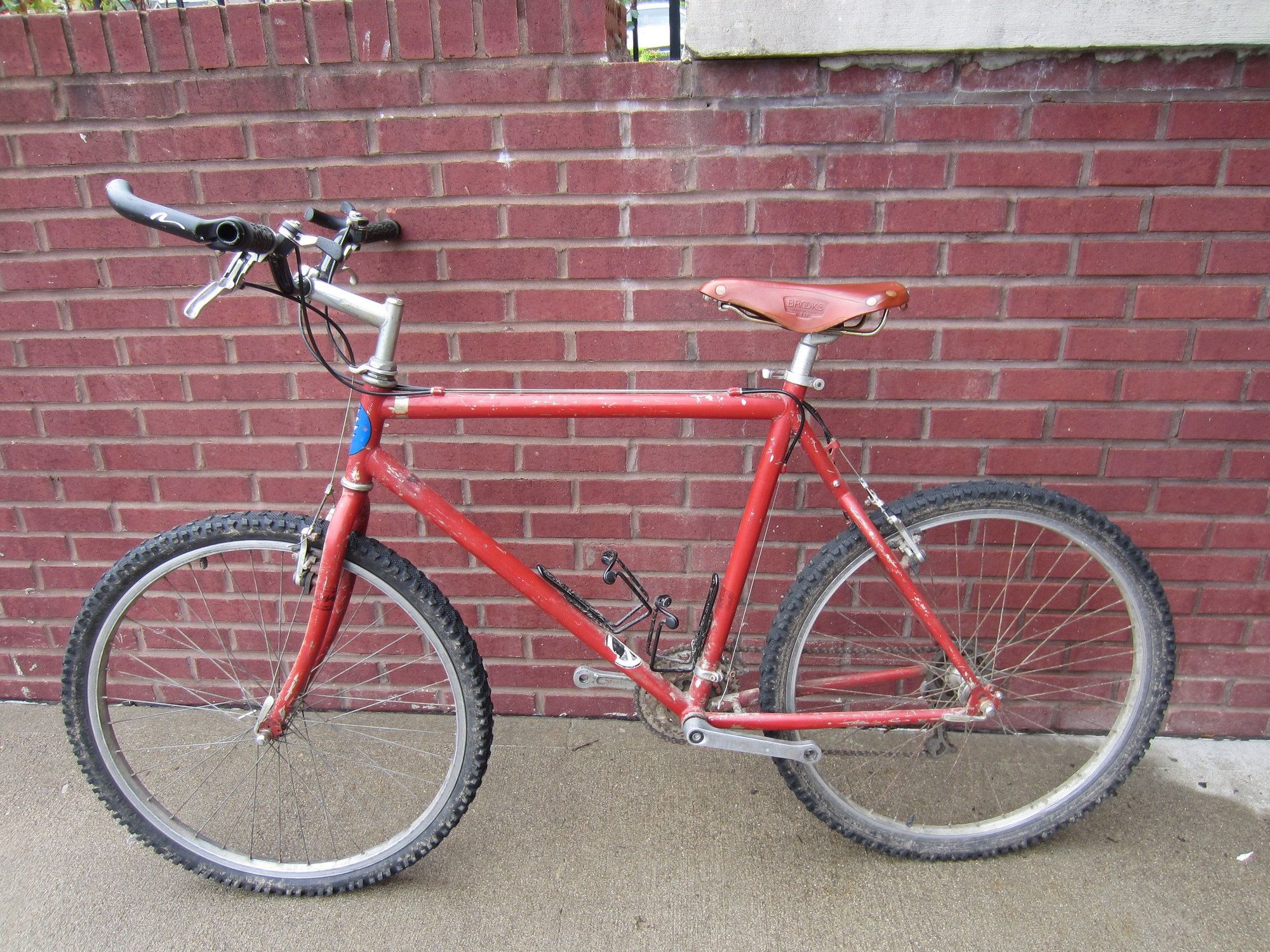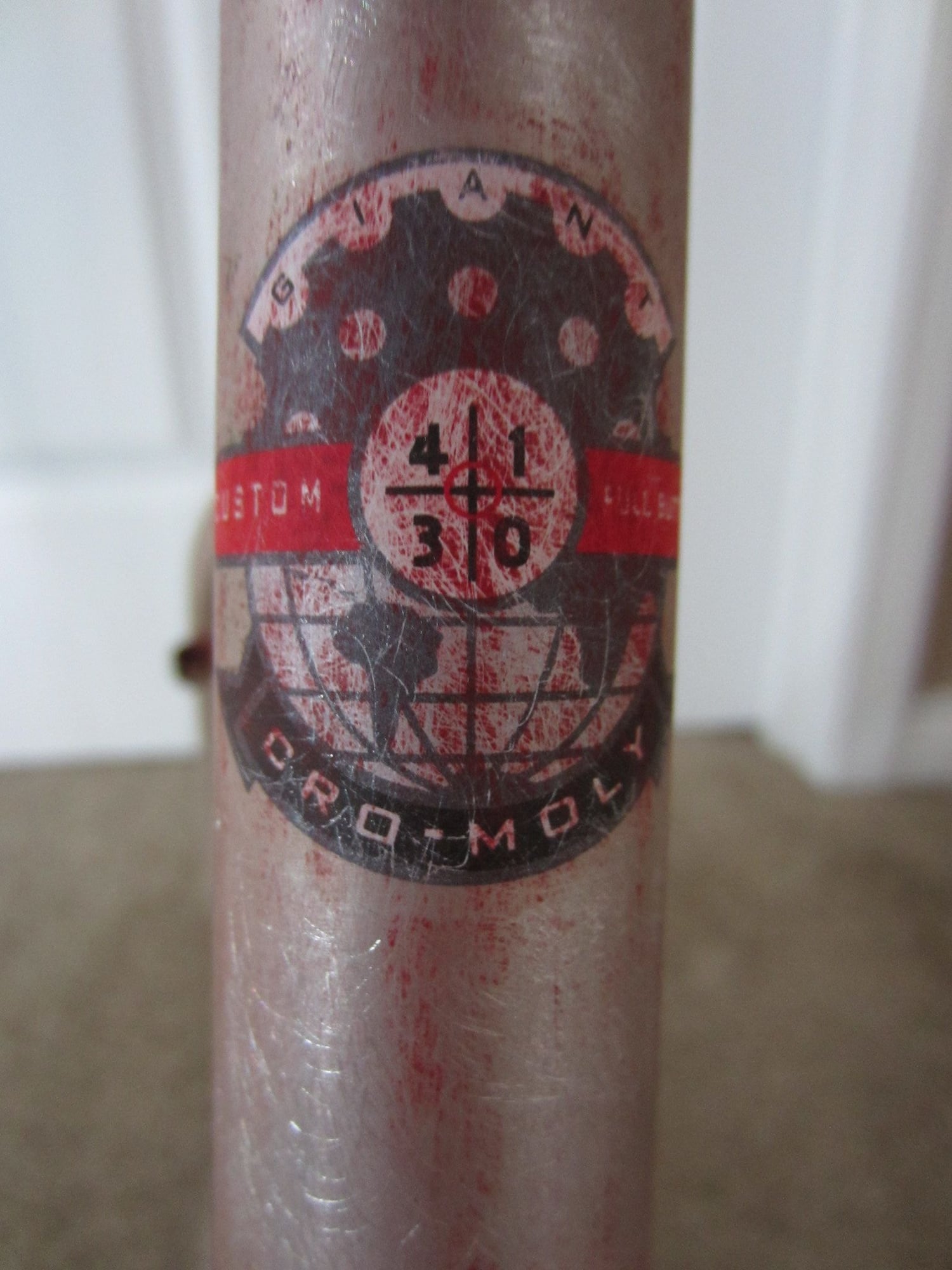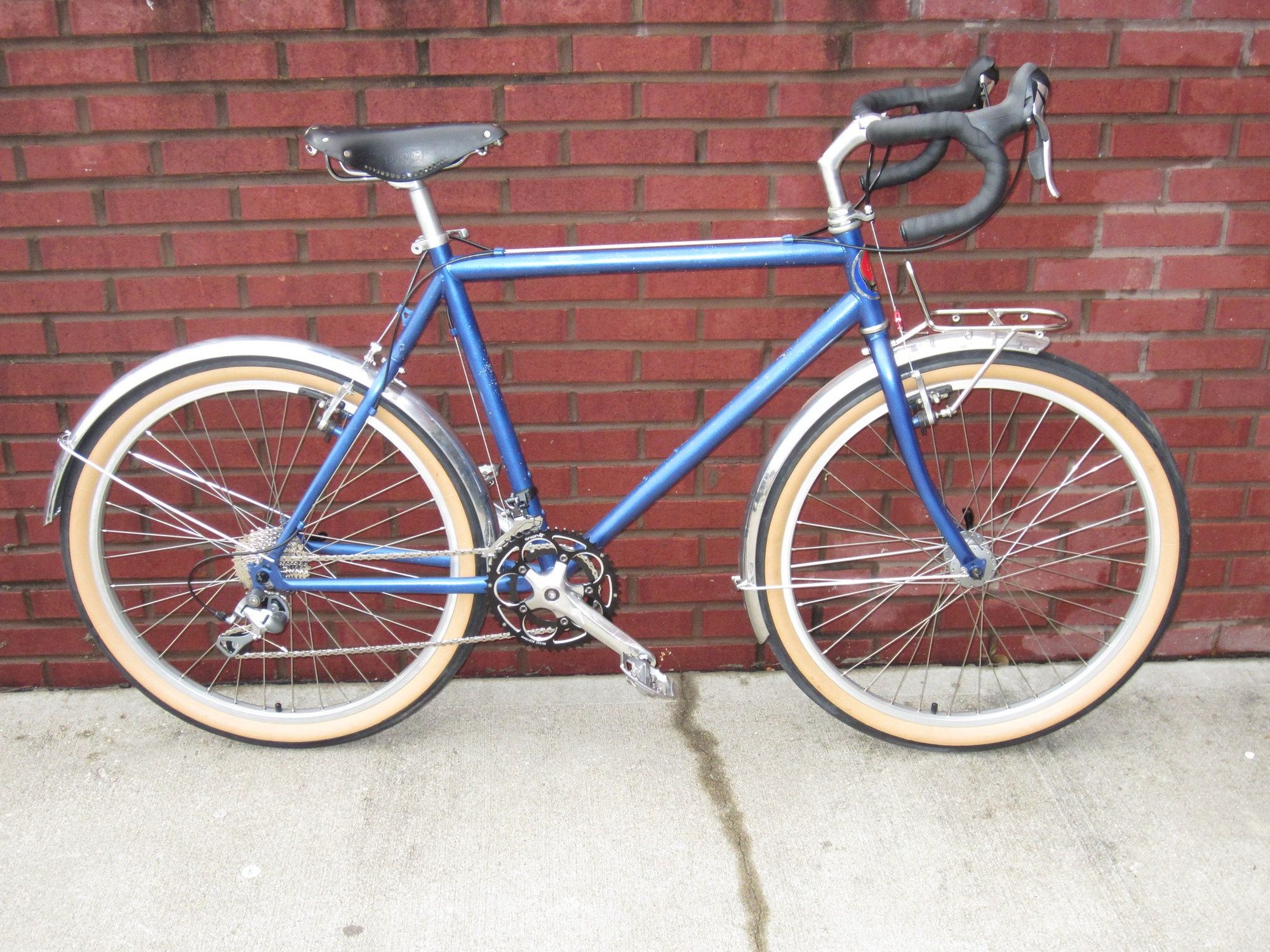Gas pipe love and other depravities.
#101
Standard Member
Join Date: Apr 2009
Location: Brunswick, Maine
Posts: 4,257
Bikes: 1948 P. Barnard & Son, 1962 Rudge Sports, 1963 Freddie Grubb Routier, 1980 Manufrance Hirondelle, 1983 F. Moser Sprint, 1989 Raleigh Technium Pre, 2001 Raleigh M80
Mentioned: 25 Post(s)
Tagged: 0 Thread(s)
Quoted: 1294 Post(s)
Liked 935 Times
in
487 Posts
Likes For 1989Pre:
#102
Senior Member
Thread Starter
Join Date: Jun 2013
Location: 700 Ft. above sea level.
Posts: 3,240
Bikes: More than there were awhile ago.
Mentioned: 22 Post(s)
Tagged: 0 Thread(s)
Quoted: 630 Post(s)
Liked 1,263 Times
in
603 Posts
Here's a couple that aren't done yet, they're "mystery" tubing.
1972 Gitane Interclub currently undergoing renovation:
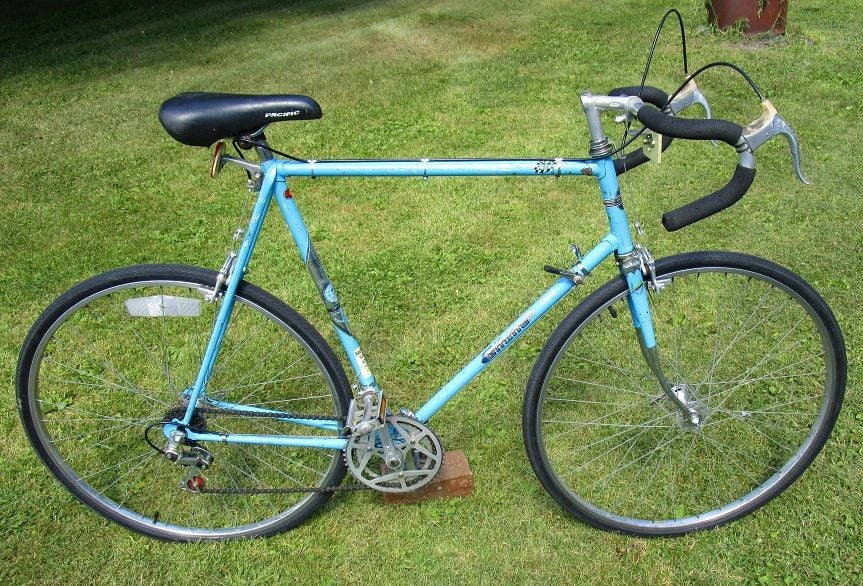
A 19?? "Clara", believed to be a rebranded Chiorda sold though a Sporting goods chain in NY state BITD. It does have some original Campy but it's Valentino that was obsolete when the bike was built. Probably got the components on clearance so they could market a "Campy equipped" bike at bargain prices.

1972 Gitane Interclub currently undergoing renovation:

A 19?? "Clara", believed to be a rebranded Chiorda sold though a Sporting goods chain in NY state BITD. It does have some original Campy but it's Valentino that was obsolete when the bike was built. Probably got the components on clearance so they could market a "Campy equipped" bike at bargain prices.

__________________
".....distasteful and easily triggered."
".....distasteful and easily triggered."
Likes For Murray Missile:
#103
Banned
Join Date: Feb 2014
Posts: 678
Mentioned: 11 Post(s)
Tagged: 0 Thread(s)
Quoted: 790 Post(s)
Liked 348 Times
in
195 Posts
The pipe used for gas-pipe in homes is very similar to rigid electrical conduit. Both are threaded on construction sites using the same equipment, usually Ridgid brand pipe cutting and threading equipment. This pipe has a thick enough wall to allow for the cutting of threads so it can be screwed together with threaded couplings. In my career as a union-electrician, I have run tons and tons of rigid electrical conduit, and have also used the same tools used for it to run gaspipe in some homes.
Gas pipe and rigid electrical conduit are low-carbon steel, they can be bent with a hand bender, usually gas pipe is not bent in installations, but electrical conduit always is bent because it saves money on expensive fittings and also because wire has to be pulled through it and it needs a radius bend to make that possible.
There is also thin-wall electrical tubing which is also low-carbon and easily bent, but it's thin walls would make it unsuitable for structural use as in a bicycle because it would probably bend very easily just from the pedaling force on a bottom-bracket.
,
The tubing used in constructing bicycle frames of lugged-frame bikes is high carbon steel, so it has a spring-like property to it, as springs themselves are made of spring-steel, which is high-carbon steel hardened to the degree where it will spring and not break. Moving up the ladder would be chrome-moly frame tubing, which has chromium and molybdenum added to the high-carbon steel, 4130 is a chrome-moly steel.
Lugged-frame bikes with high-carbon or chromoly frames will typically have non-butted tubes with a straight wall thickness close to 1 millimeter, or about .039". A butted alloy steel frame will have frame tubes that are close to one-mm at the ends and in the middle can be almost half that thickness.
Today I measured the wall-thickness of a 40+ year-old Huffy ten-speed frame I had cut up for parts with a vernier caliper and it was a solid .075" thick, almost two-mm or almost twice as thick and heavy as the tubing used on a high-end lugged frame bicycle. It is easy to see why a ten-speed frame made of tubing this thick would weigh more than twice as much as a high quality Columbus SL frame, which is why my Columbus framed Schwinn supersport weighs about ten pounds less than my Huffy ten-speed bike.
I also used to work in a metal distribution center/fab shop, employed as a fabricator/welder/machinist, and had my hands on a lot of different types of steel tubing and countless other types of metal products, which gives me some insight into how bicycles are fabricated.
So when someone tells me a bicycle is made of gas-pipe, I have a very real-world idea and expectation for what it's frame material should be, and that would be very heavy wall low-carbon steel. Not thick enough to be threaded, because the last piece of rigid electrical conduit I measured had a .150" wall, twice as thick as a Huffy frame tube, but it's frame should have tubing with a wall thickness about twice that of most lugged bikes, and be about twice as heavy as the frame of any higher priced bicycle with chromoly straight gauge or butted tubing.
Gas pipe and rigid electrical conduit are low-carbon steel, they can be bent with a hand bender, usually gas pipe is not bent in installations, but electrical conduit always is bent because it saves money on expensive fittings and also because wire has to be pulled through it and it needs a radius bend to make that possible.
There is also thin-wall electrical tubing which is also low-carbon and easily bent, but it's thin walls would make it unsuitable for structural use as in a bicycle because it would probably bend very easily just from the pedaling force on a bottom-bracket.
,
The tubing used in constructing bicycle frames of lugged-frame bikes is high carbon steel, so it has a spring-like property to it, as springs themselves are made of spring-steel, which is high-carbon steel hardened to the degree where it will spring and not break. Moving up the ladder would be chrome-moly frame tubing, which has chromium and molybdenum added to the high-carbon steel, 4130 is a chrome-moly steel.
Lugged-frame bikes with high-carbon or chromoly frames will typically have non-butted tubes with a straight wall thickness close to 1 millimeter, or about .039". A butted alloy steel frame will have frame tubes that are close to one-mm at the ends and in the middle can be almost half that thickness.
Today I measured the wall-thickness of a 40+ year-old Huffy ten-speed frame I had cut up for parts with a vernier caliper and it was a solid .075" thick, almost two-mm or almost twice as thick and heavy as the tubing used on a high-end lugged frame bicycle. It is easy to see why a ten-speed frame made of tubing this thick would weigh more than twice as much as a high quality Columbus SL frame, which is why my Columbus framed Schwinn supersport weighs about ten pounds less than my Huffy ten-speed bike.
I also used to work in a metal distribution center/fab shop, employed as a fabricator/welder/machinist, and had my hands on a lot of different types of steel tubing and countless other types of metal products, which gives me some insight into how bicycles are fabricated.
So when someone tells me a bicycle is made of gas-pipe, I have a very real-world idea and expectation for what it's frame material should be, and that would be very heavy wall low-carbon steel. Not thick enough to be threaded, because the last piece of rigid electrical conduit I measured had a .150" wall, twice as thick as a Huffy frame tube, but it's frame should have tubing with a wall thickness about twice that of most lugged bikes, and be about twice as heavy as the frame of any higher priced bicycle with chromoly straight gauge or butted tubing.
Last edited by beng1; 01-25-23 at 08:05 PM. Reason: corrected typo
#104
Ride, Wrench, Swap, Race
Join Date: Jan 2010
Location: Northern California
Posts: 9,182
Bikes: Cheltenham-Pedersen racer, Boulder F/S Paris-Roubaix, Varsity racer, '52 Christophe, '62 Continental, '92 Merckx, '75 Limongi, '76 Presto, '72 Gitane SC, '71 Schwinn SS, etc.
Mentioned: 132 Post(s)
Tagged: 0 Thread(s)
Quoted: 1562 Post(s)
Liked 1,287 Times
in
858 Posts
Safe to say then that there are no actual gas-pipe bicycles.
I always figured as much, seeing the "gas-pipe" description of bike tubing as simply being a derogatory exaggeration.
But we can perhaps broadly categorize frame steel as either "gas-pipe", "conduit" or "boutique", depending on whether the frame uses 1" tubing, or depending on whether or not the steel has significant alloying elements in it, or whether it is butted, respectively.
Good enough when we're drinking.
I always figured as much, seeing the "gas-pipe" description of bike tubing as simply being a derogatory exaggeration.
But we can perhaps broadly categorize frame steel as either "gas-pipe", "conduit" or "boutique", depending on whether the frame uses 1" tubing, or depending on whether or not the steel has significant alloying elements in it, or whether it is butted, respectively.
Good enough when we're drinking.
Likes For dddd:
#105
Senior Member
#106
Full Member
Join Date: Jun 2022
Location: San Diego, California USA
Posts: 351
Bikes: 1974 Masi GC, 1982 Trek 728 (aka 720), 1992 Trek Multitrack 750
Mentioned: 0 Post(s)
Tagged: 0 Thread(s)
Quoted: 118 Post(s)
Liked 219 Times
in
139 Posts
I love the title of this thread: "Gas pipe love and other depravities"
Likes For HelpSingularity:
Likes For HelpSingularity:
#108
Senior Member
Likes For Hondo6:
#109
Senior Member
Join Date: Jan 2005
Location: Baltimore, MD
Posts: 5,364
Mentioned: 15 Post(s)
Tagged: 0 Thread(s)
Quoted: 2479 Post(s)
Liked 2,948 Times
in
1,674 Posts
The pipe used for gas-pipe in homes is very similar to rigid electrical conduit. Both are threaded on construction sites using the same equipment, usually Ridgid brand pipe cutting and threading equipment. This pipe has a thick enough wall to allow for the cutting of threads so it can be screwed together with threaded couplings. In my career as a union-electrician, I have run tons and tons of rigid electrical conduit, and have also used the same tools used for it to run gaspipe in some homes.
Gas pipe and rigid electrical conduit are low-carbon steel, they can be bent with a hand bender, usually gas pipe is not bent in installations, but electrical conduit always is bent because it saves money on expensive fittings and also because wire has to be pulled through it and it needs a radius bend to make that possible.
There is also thin-wall electrical tubing which is also low-carbon and easily bent, but it's thin walls would make it unsuitable for structural use as in a bicycle because it would probably bend very easily just from the pedaling force on a bottom-bracket.
,
The tubing used in constructing bicycle frames of lugged-frame bikes is high carbon steel, so it has a spring-like property to it, as springs themselves are made of spring-steel, which is high-carbon steel hardened to the degree where it will spring and not break. Moving up the ladder would be chrome-moly frame tubing, which has chromium and molybdenum added to the high-carbon steel, 4130 is a chrome-moly steel.
Lugged-frame bikes with high-carbon or chromoly frames will typically have non-butted tubes with a straight wall thickness close to 1 millimeter, or about .039". A butted alloy steel frame will have frame tubes that are close to one-mm at the ends and in the middle can be almost half that thickness.
Today I measured the wall-thickness of a 40+ year-old Huffy ten-speed frame I had cut up for parts with a vernier caliper and it was a solid .75" thick, almost two-mm or almost twice as thick and heavy as the tubing used on a high-end lugged frame bicycle. It is easy to see why a ten-speed frame made of tubing this thick would weigh more than twice as much as a high quality Columbus SL frame, which is why my Columbus framed Schwinn supersport weighs about ten pounds less than my Huffy ten-speed bike.
I also used to work in a metal distribution center/fab shop, employed as a fabricator/welder/machinist, and had my hands on a lot of different types of steel tubing and countless other types of metal products, which gives me some insight into how bicycles are fabricated.
So when someone tells me a bicycle is made of gas-pipe, I have a very real-world idea and expectation for what it's frame material should be, and that would be very heavy wall low-carbon steel. Not thick enough to be threaded, because the last piece of rigid electrical conduit I measured had a .150" wall, twice as thick as a Huffy frame tube, but it's frame should have tubing with a wall thickness about twice that of most lugged bikes, and be about twice as heavy as the frame of any higher priced bicycle with chromoly straight gauge or butted tubing.
Gas pipe and rigid electrical conduit are low-carbon steel, they can be bent with a hand bender, usually gas pipe is not bent in installations, but electrical conduit always is bent because it saves money on expensive fittings and also because wire has to be pulled through it and it needs a radius bend to make that possible.
There is also thin-wall electrical tubing which is also low-carbon and easily bent, but it's thin walls would make it unsuitable for structural use as in a bicycle because it would probably bend very easily just from the pedaling force on a bottom-bracket.
,
The tubing used in constructing bicycle frames of lugged-frame bikes is high carbon steel, so it has a spring-like property to it, as springs themselves are made of spring-steel, which is high-carbon steel hardened to the degree where it will spring and not break. Moving up the ladder would be chrome-moly frame tubing, which has chromium and molybdenum added to the high-carbon steel, 4130 is a chrome-moly steel.
Lugged-frame bikes with high-carbon or chromoly frames will typically have non-butted tubes with a straight wall thickness close to 1 millimeter, or about .039". A butted alloy steel frame will have frame tubes that are close to one-mm at the ends and in the middle can be almost half that thickness.
Today I measured the wall-thickness of a 40+ year-old Huffy ten-speed frame I had cut up for parts with a vernier caliper and it was a solid .75" thick, almost two-mm or almost twice as thick and heavy as the tubing used on a high-end lugged frame bicycle. It is easy to see why a ten-speed frame made of tubing this thick would weigh more than twice as much as a high quality Columbus SL frame, which is why my Columbus framed Schwinn supersport weighs about ten pounds less than my Huffy ten-speed bike.
I also used to work in a metal distribution center/fab shop, employed as a fabricator/welder/machinist, and had my hands on a lot of different types of steel tubing and countless other types of metal products, which gives me some insight into how bicycles are fabricated.
So when someone tells me a bicycle is made of gas-pipe, I have a very real-world idea and expectation for what it's frame material should be, and that would be very heavy wall low-carbon steel. Not thick enough to be threaded, because the last piece of rigid electrical conduit I measured had a .150" wall, twice as thick as a Huffy frame tube, but it's frame should have tubing with a wall thickness about twice that of most lugged bikes, and be about twice as heavy as the frame of any higher priced bicycle with chromoly straight gauge or butted tubing.
On this topic, I've always wondered whether the first steel bikes were literally built with gas pipe, i.e., with pipe that was conveniently available for use in bike fabrication because it was already being manufactured in great quantities for use in the distribution of gas throughout towns and cities for use in commercial and residential properties, in street lighting, etc. (A standard dimension for the outer diameter of both gas pipes and bike tubing in the 19th century was one inch, I believe.) So I just did a search and found this:
"By the early 1800's, Paris and London had installed gas lamps along their streets. The added light increased accessibility and demand for nighttime activities, changing the nighttime culture from one of shutting oneself in to going out and socializing with others."
Coincidentally, I learned only yesterday that the first patent for a more or less modern bicycle (crank drive, rotating pedals rather than stationary pegs, etc.) was issued in 1866, in my home town of New Haven.
I guess that explains why bike manufacturers are said to use gas pipe. If bikes had come first, would my gas stove use bike pipes?
Likes For Trakhak:
#110
Ride, Wrench, Swap, Race
Join Date: Jan 2010
Location: Northern California
Posts: 9,182
Bikes: Cheltenham-Pedersen racer, Boulder F/S Paris-Roubaix, Varsity racer, '52 Christophe, '62 Continental, '92 Merckx, '75 Limongi, '76 Presto, '72 Gitane SC, '71 Schwinn SS, etc.
Mentioned: 132 Post(s)
Tagged: 0 Thread(s)
Quoted: 1562 Post(s)
Liked 1,287 Times
in
858 Posts
Great information. Thanks. I don't believe there's been an earlier post by anyone on Bike Forums that discussed the characteristics of low-carbon versus high-carbon steel in bike fabrication. Certainly not in anything like this depth. There's a lot to digest here.
On this topic, I've always wondered whether the first steel bikes were literally built with gas pipe, i.e., with pipe that was conveniently available for use in bike fabrication because it was already being manufactured in great quantities for use in the distribution of gas throughout towns and cities for use in commercial and residential properties, in street lighting, etc. (A standard dimension for the outer diameter of both gas pipes and bike tubing in the 19th century was one inch, I believe.) So I just did a search and found this:
"By the early 1800's, Paris and London had installed gas lamps along their streets. The added light increased accessibility and demand for nighttime activities, changing the nighttime culture from one of shutting oneself in to going out and socializing with others."
Coincidentally, I learned only yesterday that the first patent for a more or less modern bicycle (crank drive, rotating pedals rather than stationary pegs, etc.) was issued in 1866, in my home town of New Haven.
I guess that explains why bike manufacturers are said to use gas pipe. If bikes had come first, would my gas stove use bike pipes?
On this topic, I've always wondered whether the first steel bikes were literally built with gas pipe, i.e., with pipe that was conveniently available for use in bike fabrication because it was already being manufactured in great quantities for use in the distribution of gas throughout towns and cities for use in commercial and residential properties, in street lighting, etc. (A standard dimension for the outer diameter of both gas pipes and bike tubing in the 19th century was one inch, I believe.) So I just did a search and found this:
"By the early 1800's, Paris and London had installed gas lamps along their streets. The added light increased accessibility and demand for nighttime activities, changing the nighttime culture from one of shutting oneself in to going out and socializing with others."
Coincidentally, I learned only yesterday that the first patent for a more or less modern bicycle (crank drive, rotating pedals rather than stationary pegs, etc.) was issued in 1866, in my home town of New Haven.
I guess that explains why bike manufacturers are said to use gas pipe. If bikes had come first, would my gas stove use bike pipes?
Earlier (chainless) bikes though used various grades of castings and cold-worked iron or steel, and lots of wood before that.
Aircraft were first to use familiar lightweight steel tubing (why Reynolds 531 was created).
#111
Banned
Join Date: Feb 2014
Posts: 678
Mentioned: 11 Post(s)
Tagged: 0 Thread(s)
Quoted: 790 Post(s)
Liked 348 Times
in
195 Posts
Right, I corrected the typo, or maybe switching between fractions of a millimeter and English measurements is confusing. A problem us USA people have because our country uses both measurement systems. Even worse, my father was a dealer/racer of British motorcycles and I grew up with British Whitworth and other odd measuring systems. One of the 1970s Norton motorcycles I had used USA. British and metric bolts and nuts all at once, that is how it was made.... !!!
#112
Banned
Join Date: Feb 2014
Posts: 678
Mentioned: 11 Post(s)
Tagged: 0 Thread(s)
Quoted: 790 Post(s)
Liked 348 Times
in
195 Posts
Great information. Thanks. I don't believe there's been an earlier post by anyone on Bike Forums that discussed the characteristics of low-carbon versus high-carbon steel in bike fabrication. Certainly not in anything like this depth. There's a lot to digest here.
On this topic, I've always wondered whether the first steel bikes were literally built with gas pipe, i.e., with pipe that was conveniently available for use in bike fabrication because it was already being manufactured in great quantities for use in the distribution of gas throughout towns and cities for use in commercial and residential properties, in street lighting, etc. (A standard dimension for the outer diameter of both gas pipes and bike tubing in the 19th century was one inch, I believe.) So I just did a search and found this:
"By the early 1800's, Paris and London had installed gas lamps along their streets. The added light increased accessibility and demand for nighttime activities, changing the nighttime culture from one of shutting oneself in to going out and socializing with others."
Coincidentally, I learned only yesterday that the first patent for a more or less modern bicycle (crank drive, rotating pedals rather than stationary pegs, etc.) was issued in 1866, in my home town of New Haven.
I guess that explains why bike manufacturers are said to use gas pipe. If bikes had come first, would my gas stove use bike pipes?
On this topic, I've always wondered whether the first steel bikes were literally built with gas pipe, i.e., with pipe that was conveniently available for use in bike fabrication because it was already being manufactured in great quantities for use in the distribution of gas throughout towns and cities for use in commercial and residential properties, in street lighting, etc. (A standard dimension for the outer diameter of both gas pipes and bike tubing in the 19th century was one inch, I believe.) So I just did a search and found this:
"By the early 1800's, Paris and London had installed gas lamps along their streets. The added light increased accessibility and demand for nighttime activities, changing the nighttime culture from one of shutting oneself in to going out and socializing with others."
Coincidentally, I learned only yesterday that the first patent for a more or less modern bicycle (crank drive, rotating pedals rather than stationary pegs, etc.) was issued in 1866, in my home town of New Haven.
I guess that explains why bike manufacturers are said to use gas pipe. If bikes had come first, would my gas stove use bike pipes?
I imagine in the earliest days of bicycle manufacture, with the small choice of metal tubing there was, a lot of the same quality and type of tubing was used for a very wide variety of manufactured items.
I realize that "gaspipe" bike is just a figure of speech, but I wanted to make people aware that the mass-produced department store bicycles made in the USA in the 1970s and earlier, which had butt-welded or brazed frames with no lugs, are a LOT closer to being like real gas pipe than any of the lugged frame bikes, or the tig-welded chromoly mountain-bikes and other bikes.
Likes For beng1:
#113
Banned
Join Date: Feb 2014
Posts: 678
Mentioned: 11 Post(s)
Tagged: 0 Thread(s)
Quoted: 790 Post(s)
Liked 348 Times
in
195 Posts
I am particularly proud of my Huffy's solid-steel centerpull brake calipers, wheel hubs, crankset and derailleurs, items which lesser bikes use cheap weak aluminum for;
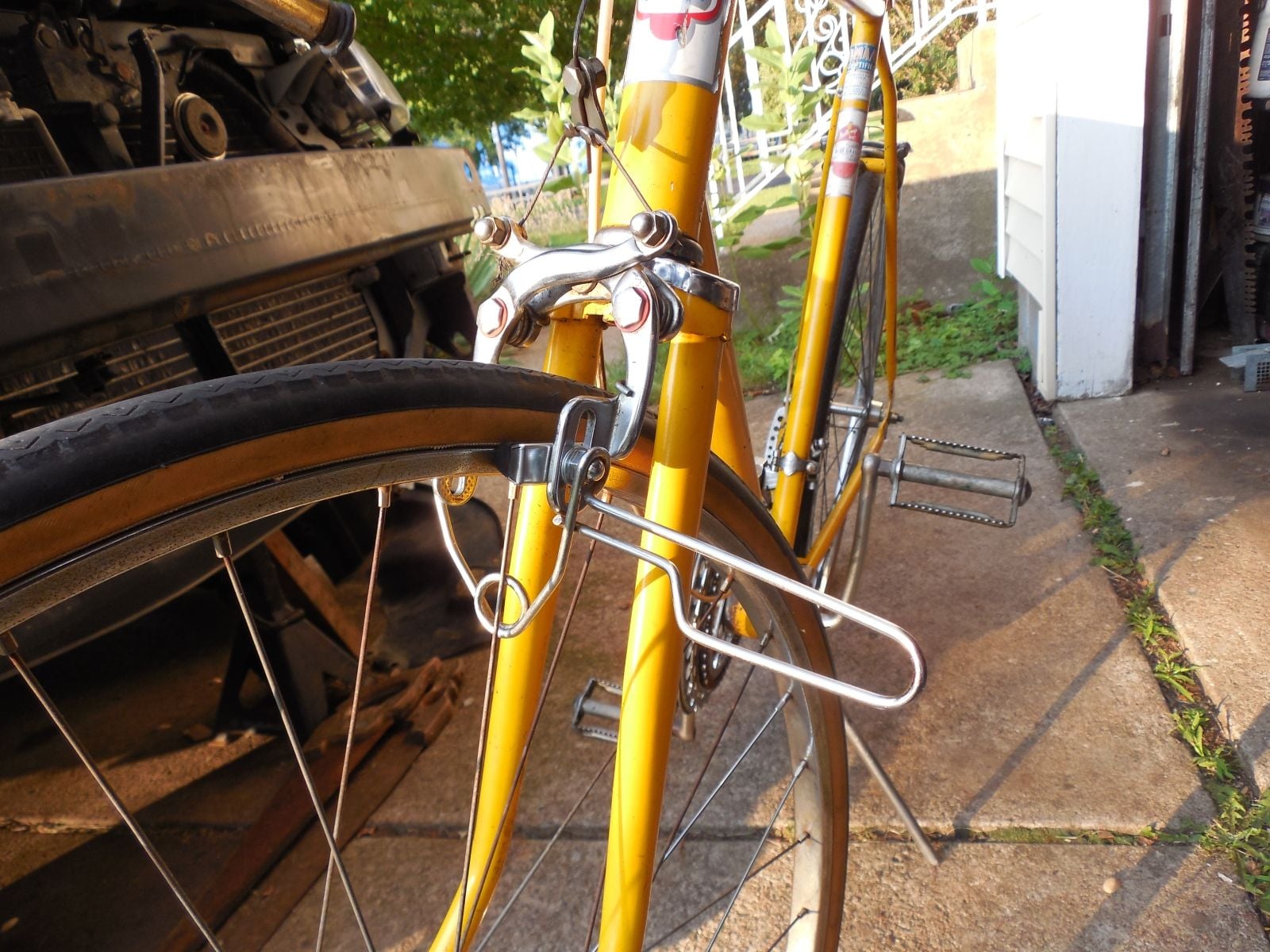
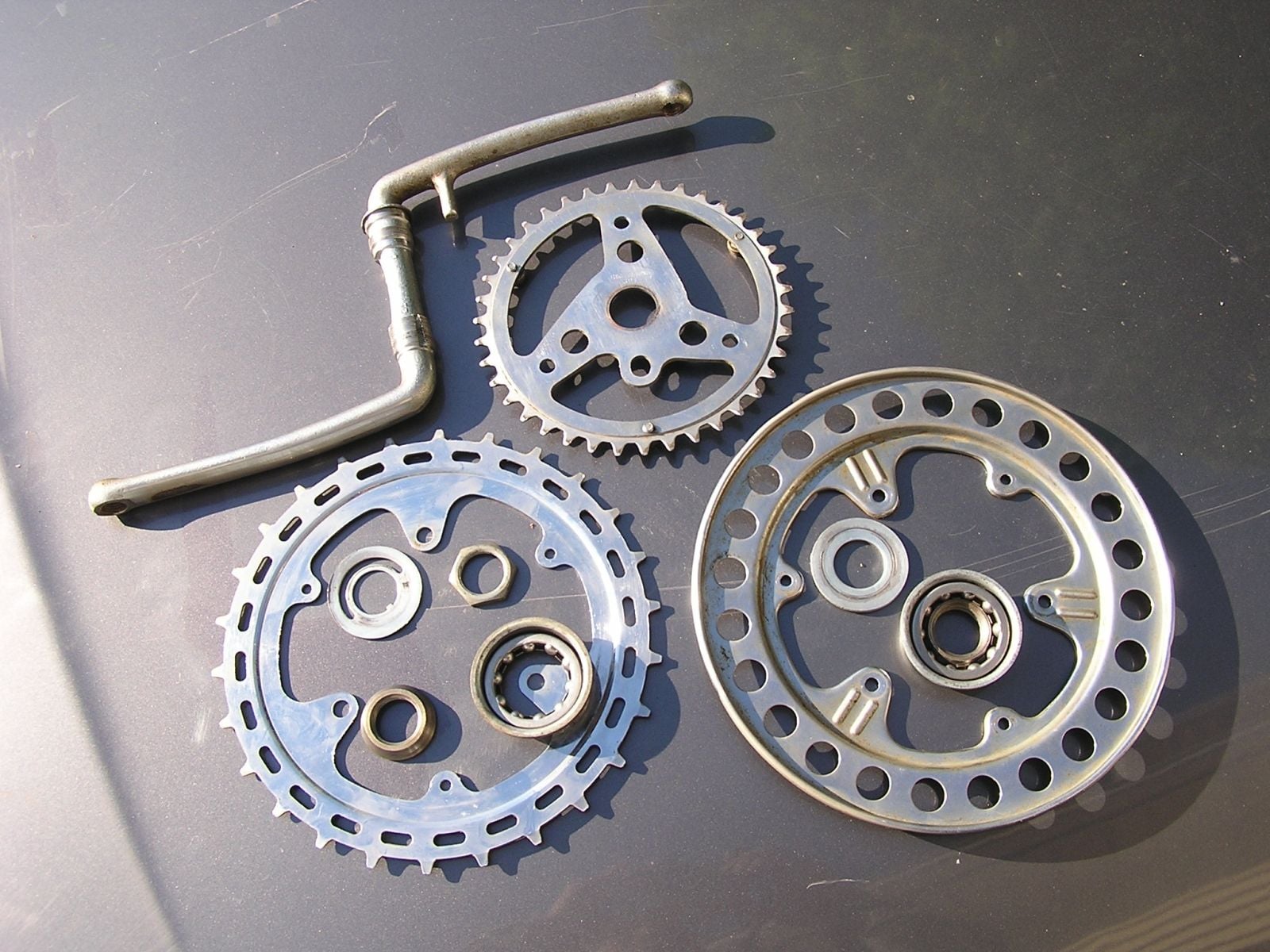

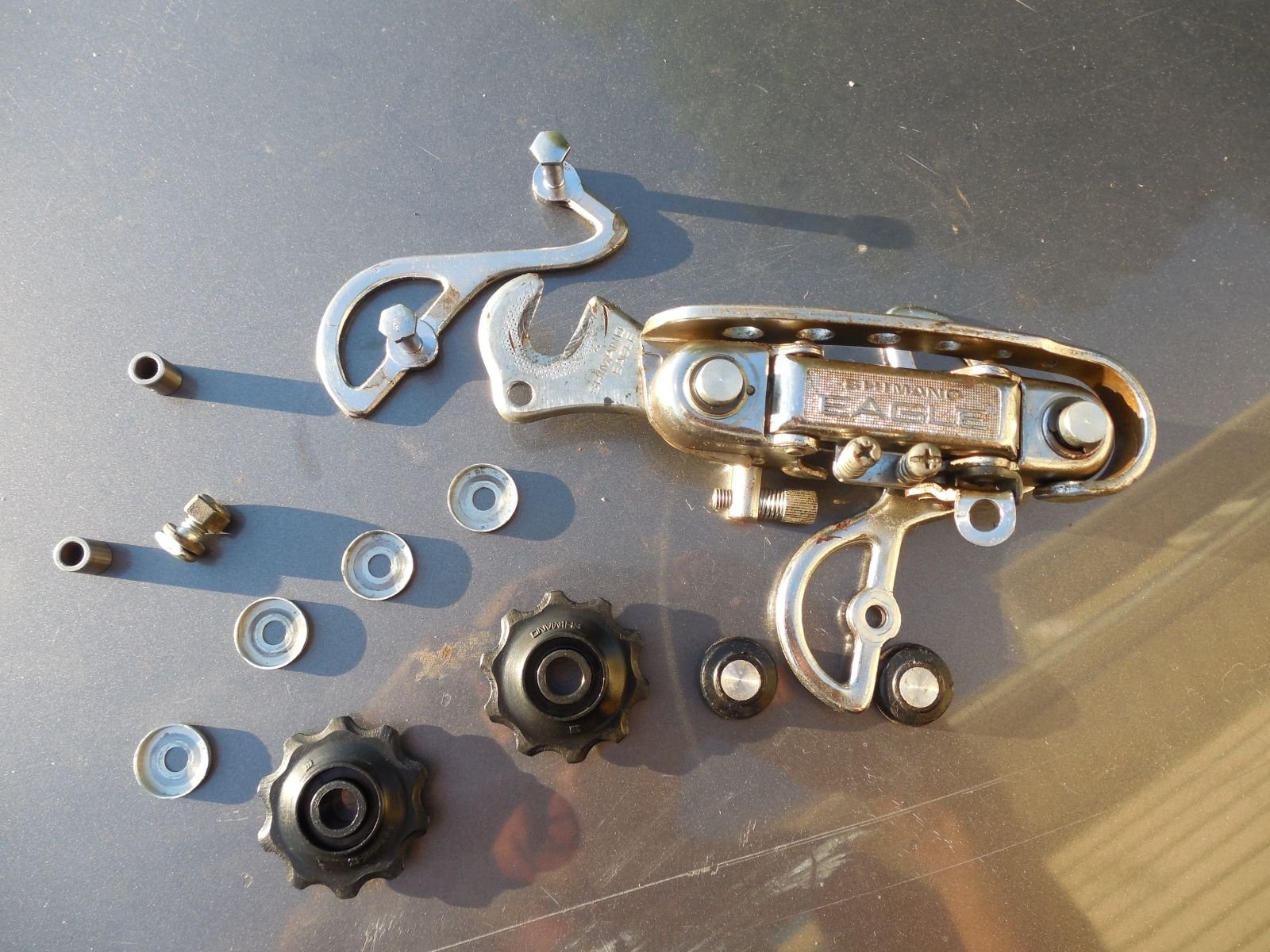
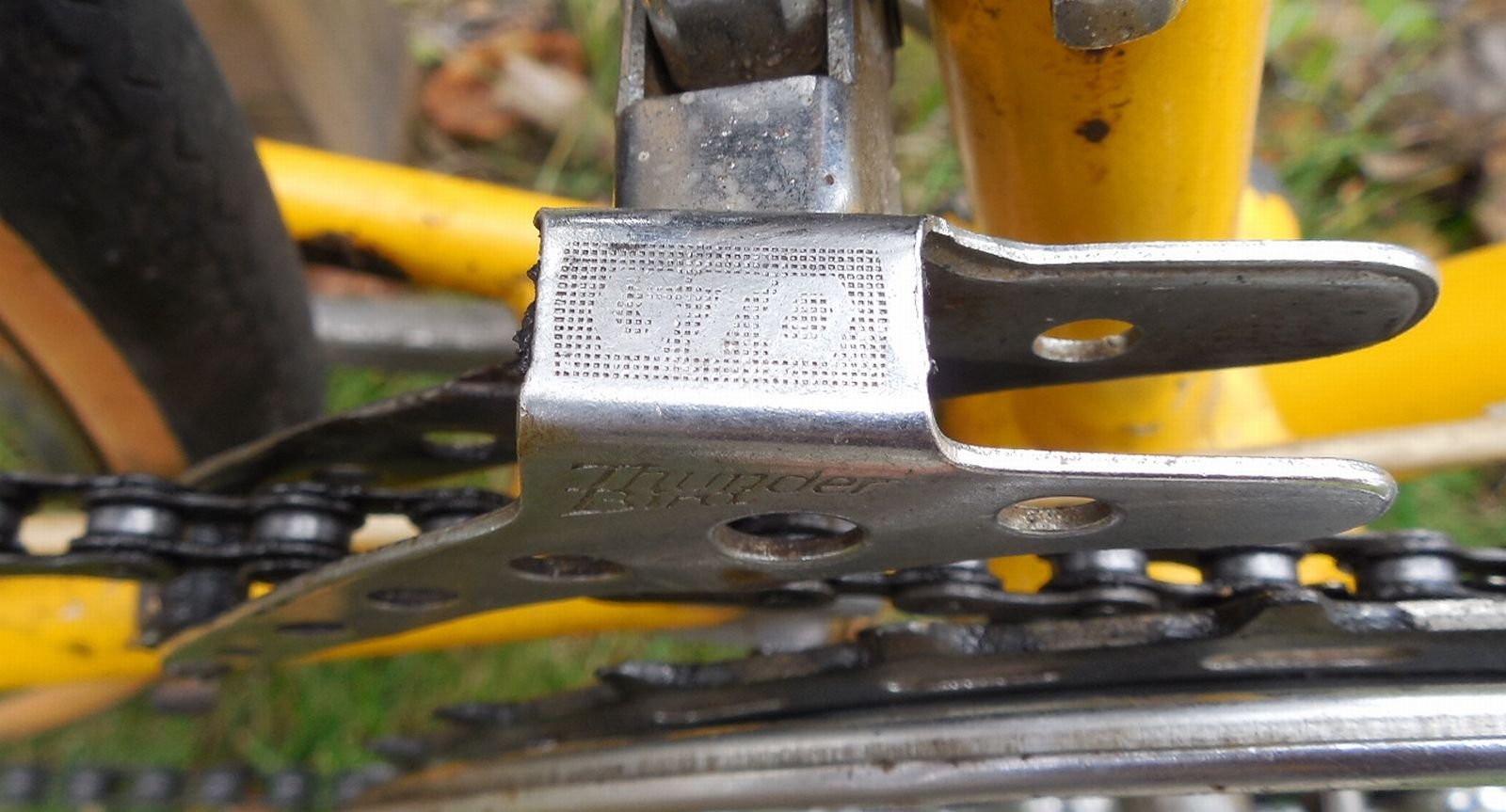





#114
Live not by lies.
Join Date: Nov 2020
Posts: 1,306
Bikes: BigBox bikes.
Mentioned: 3 Post(s)
Tagged: 0 Thread(s)
Quoted: 860 Post(s)
Liked 784 Times
in
582 Posts
I collect old hand tools and have done a lot of research on the early industrial era. I doubt there was a lot of variety in metal tubing until the late 1800s. I had an 1899 Pierce bicycle which had thin-wall carbon steel tubes of a very high quality and it was a very light bike, but it was an exception and not a rule. Most of the steel in the USA came from England until in the mid 1800s the USA started to get steel mills. On a lot of old USA tools you will see them marked "London Spring Steel". The first USA hand-saw manufacturer to get it's own steel mill, and thus the ability to undercut the prices of all it's competitors, was Disston in Pennsylvania, and it quickly put most other saw manufacturers out of business by 1900 because of it and became the largest saw manufacturer on Earth through WWII.
I imagine in the earliest days of bicycle manufacture, with the small choice of metal tubing there was, a lot of the same quality and type of tubing was used for a very wide variety of manufactured items.
I realize that "gaspipe" bike is just a figure of speech, but I wanted to make people aware that the mass-produced department store bicycles made in the USA in the 1970s and earlier, which had butt-welded or brazed frames with no lugs, are a LOT closer to being like real gas pipe than any of the lugged frame bikes, or the tig-welded chromoly mountain-bikes and other bikes.
I imagine in the earliest days of bicycle manufacture, with the small choice of metal tubing there was, a lot of the same quality and type of tubing was used for a very wide variety of manufactured items.
I realize that "gaspipe" bike is just a figure of speech, but I wanted to make people aware that the mass-produced department store bicycles made in the USA in the 1970s and earlier, which had butt-welded or brazed frames with no lugs, are a LOT closer to being like real gas pipe than any of the lugged frame bikes, or the tig-welded chromoly mountain-bikes and other bikes.
I’m not overwhelmingly convinced the seam in pipe makes it meaningfully weaker or is enough of a stress riser to be concerned about.
Maybe at the wall thickness of bike frames or if it couldn’t be butted to make a lighter frame because of the seam.
But I think calling low end old bikes “gas pipes” is close enough to reality.
Likes For SkinGriz:
#115
Standard Member
Join Date: Apr 2009
Location: Brunswick, Maine
Posts: 4,257
Bikes: 1948 P. Barnard & Son, 1962 Rudge Sports, 1963 Freddie Grubb Routier, 1980 Manufrance Hirondelle, 1983 F. Moser Sprint, 1989 Raleigh Technium Pre, 2001 Raleigh M80
Mentioned: 25 Post(s)
Tagged: 0 Thread(s)
Quoted: 1294 Post(s)
Liked 935 Times
in
487 Posts
Does anyone have the hardness specs on any of the hi-ten tubesets?
Here is one, which is used on my Nervex-lugged Grubb:
Reynolds 'A' Quality 2030 drawn, butted
(U.T.S.: 541 Mpa/ 455 N/mm2)
post-brazing strength: 312 N/mm2 (27,000 psi)
(I don't know the yield strength.)
Here is one, which is used on my Nervex-lugged Grubb:
Reynolds 'A' Quality 2030 drawn, butted
(U.T.S.: 541 Mpa/ 455 N/mm2)
post-brazing strength: 312 N/mm2 (27,000 psi)
(I don't know the yield strength.)
__________________
Unless you climb the rungs strategically, you’re not going to build the muscle you need to stay at the top.
Unless you climb the rungs strategically, you’re not going to build the muscle you need to stay at the top.
Last edited by 1989Pre; 01-26-23 at 04:41 AM.
#116
Senior Member
Join Date: Jan 2005
Location: Baltimore, MD
Posts: 5,364
Mentioned: 15 Post(s)
Tagged: 0 Thread(s)
Quoted: 2479 Post(s)
Liked 2,948 Times
in
1,674 Posts
I collect old hand tools and have done a lot of research on the early industrial era. I doubt there was a lot of variety in metal tubing until the late 1800s. I had an 1899 Pierce bicycle which had thin-wall carbon steel tubes of a very high quality and it was a very light bike, but it was an exception and not a rule. Most of the steel in the USA came from England until in the mid 1800s the USA started to get steel mills. On a lot of old USA tools you will see them marked "London Spring Steel". The first USA hand-saw manufacturer to get it's own steel mill, and thus the ability to undercut the prices of all it's competitors, was Disston in Pennsylvania, and it quickly put most other saw manufacturers out of business by 1900 because of it and became the largest saw manufacturer on Earth through WWII.
I imagine in the earliest days of bicycle manufacture, with the small choice of metal tubing there was, a lot of the same quality and type of tubing was used for a very wide variety of manufactured items.
I realize that "gaspipe" bike is just a figure of speech, but I wanted to make people aware that the mass-produced department store bicycles made in the USA in the 1970s and earlier, which had butt-welded or brazed frames with no lugs, are a LOT closer to being like real gas pipe than any of the lugged frame bikes, or the tig-welded chromoly mountain-bikes and other bikes.
I imagine in the earliest days of bicycle manufacture, with the small choice of metal tubing there was, a lot of the same quality and type of tubing was used for a very wide variety of manufactured items.
I realize that "gaspipe" bike is just a figure of speech, but I wanted to make people aware that the mass-produced department store bicycles made in the USA in the 1970s and earlier, which had butt-welded or brazed frames with no lugs, are a LOT closer to being like real gas pipe than any of the lugged frame bikes, or the tig-welded chromoly mountain-bikes and other bikes.
---The Sheffield steelmaking district had little or no reputation outside the area before Benjamin Huntsman invented crucible steel in 1742. The early steelmakers simply supplied the cutlers, but by the mid nineteenth century nearly half the European output of steel was made in the Sheffield district.
[Edit: "cutler: a person who makes or sells cutlery"]
The South Yorkshire Steel Industry and the Industrial Revolution
Likes For Trakhak:
#117
Standard Member
Join Date: Apr 2009
Location: Brunswick, Maine
Posts: 4,257
Bikes: 1948 P. Barnard & Son, 1962 Rudge Sports, 1963 Freddie Grubb Routier, 1980 Manufrance Hirondelle, 1983 F. Moser Sprint, 1989 Raleigh Technium Pre, 2001 Raleigh M80
Mentioned: 25 Post(s)
Tagged: 0 Thread(s)
Quoted: 1294 Post(s)
Liked 935 Times
in
487 Posts
If there is one steel component that should have a following on modern, rim-brake bikes, it is the brake calipers. The next time you are descending gleefully at 40mph and spot a family of geese making their way-cross, 30 feet ahead, you will know why. No flex. On my 1948 show-piece, I have steel hubs, crank-set, b.b., handlebar, 4-sp derailleur, brake calipers and levers, pedals and toe-clips. I could afford aluminum, but I also like to annoy the swells.
__________________
Unless you climb the rungs strategically, you’re not going to build the muscle you need to stay at the top.
Unless you climb the rungs strategically, you’re not going to build the muscle you need to stay at the top.
Likes For 1989Pre:
#118
Banned
Join Date: Feb 2014
Posts: 678
Mentioned: 11 Post(s)
Tagged: 0 Thread(s)
Quoted: 790 Post(s)
Liked 348 Times
in
195 Posts
If there is one steel component that should have a following on modern, rim-brake bikes, it is the brake calipers. The next time you are descending gleefully at 40mph and spot a family of geese making their way-cross, 30 feet ahead, you will know why. No flex. On my 1948 show-piece, I have steel hubs, crank-set, b.b., handlebar, 4-sp derailleur, brake calipers and levers, pedals and toe-clips. I could afford aluminum, but I also like to annoy the swells.
#119
Senior Member
Join Date: Jan 2005
Location: Baltimore, MD
Posts: 5,364
Mentioned: 15 Post(s)
Tagged: 0 Thread(s)
Quoted: 2479 Post(s)
Liked 2,948 Times
in
1,674 Posts
Unfortunately, the only steel brakes on the market in the modern era are designed and manufactured to reach the lowest possible price point. Quality is barely a consideration. With disc brakes dominating the market for the foreseeable future, we're unlikely to see the return of high-quality steel rim brakes.
Here's a review of a couple of brakes designed by engineers who considered the standard aluminum brakes available road bikes sadly lacking. Great article. Thanks are due to SpeedofLite for posting it.
Here's a review of a couple of brakes designed by engineers who considered the standard aluminum brakes available road bikes sadly lacking. Great article. Thanks are due to SpeedofLite for posting it.
Equipment/Product Review (1988) SCOTT Superbrake / MATHAUSER Hydraulic Brake
#120
Full Member
Join Date: May 2022
Location: Dixiana, AL
Posts: 250
Bikes: 1993 Diamond Back Sorrento, 1965 Schwinn Racer 3-speed, 1987 Schwinn High Sierra, 1990 Specialized Sirrus, 2020 Specialized Sirrus 3.0, 2013 Giant Seek 1
Mentioned: 3 Post(s)
Tagged: 0 Thread(s)
Quoted: 87 Post(s)
Liked 776 Times
in
199 Posts
I picked up this fine example of mid-70's gas pipe depravity today. Complete with the trifecta of depravities - turkey levers (marked LH and RH just in case you get confused), stem shifters, and horror of horrors a metal dork disc. Additional bonus, a bolt-on kickstand! What sealed the deal for me was the glitter vinyl wrapped combination chain lock that was so common BITD. 
Montgomery Ward 10 Speed


Montgomery Ward 10 Speed

Likes For zookster:
#121
Standard Member
Join Date: Apr 2009
Location: Brunswick, Maine
Posts: 4,257
Bikes: 1948 P. Barnard & Son, 1962 Rudge Sports, 1963 Freddie Grubb Routier, 1980 Manufrance Hirondelle, 1983 F. Moser Sprint, 1989 Raleigh Technium Pre, 2001 Raleigh M80
Mentioned: 25 Post(s)
Tagged: 0 Thread(s)
Quoted: 1294 Post(s)
Liked 935 Times
in
487 Posts
If you look at center-pull brakes, the arm pivot is a lot closer to the brake pad than on side-pull brakes, sometimes about twice as close, so the sidepull arm might have to endure four times the stress of a center-pull arm, because I believe the force on a lever increases exponentially with distance. And many times the arms of early side-pull alloy brake arms are the same size in cross-section as their center-pull cousins. And aluminum being about half the strength of steel, and also much more likely to crack and break from work-hardening under flex, would seem to make an alloy side-pull eight times more likely to break in hard use than a steel centerpull, and four times more likely to break than an alloy centerpull. Modern side-pulls are a lot more compact with shorter beefier arms and I am sure safe. But I have a pair of 70s side-pulls off a Schwinn with very skinny looking arms which I at 200 pounds, do not think I want to gamble on .
__________________
Unless you climb the rungs strategically, you’re not going to build the muscle you need to stay at the top.
Unless you climb the rungs strategically, you’re not going to build the muscle you need to stay at the top.
Likes For 1989Pre:
#122
Standard Member
Join Date: Apr 2009
Location: Brunswick, Maine
Posts: 4,257
Bikes: 1948 P. Barnard & Son, 1962 Rudge Sports, 1963 Freddie Grubb Routier, 1980 Manufrance Hirondelle, 1983 F. Moser Sprint, 1989 Raleigh Technium Pre, 2001 Raleigh M80
Mentioned: 25 Post(s)
Tagged: 0 Thread(s)
Quoted: 1294 Post(s)
Liked 935 Times
in
487 Posts
I picked up this fine example of mid-70's gas pipe depravity today. Complete with the trifecta of depravities - turkey levers (marked LH and RH just in case you get confused), stem shifters, and horror of horrors a metal dork disc. Additional bonus, a bolt-on kickstand! What sealed the deal for me was the glitter vinyl wrapped combination chain lock that was so common BITD. 
Montgomery Ward 10 Speed


Montgomery Ward 10 Speed

__________________
Unless you climb the rungs strategically, you’re not going to build the muscle you need to stay at the top.
Unless you climb the rungs strategically, you’re not going to build the muscle you need to stay at the top.
#123
Full Member
Join Date: May 2022
Location: Dixiana, AL
Posts: 250
Bikes: 1993 Diamond Back Sorrento, 1965 Schwinn Racer 3-speed, 1987 Schwinn High Sierra, 1990 Specialized Sirrus, 2020 Specialized Sirrus 3.0, 2013 Giant Seek 1
Mentioned: 3 Post(s)
Tagged: 0 Thread(s)
Quoted: 87 Post(s)
Liked 776 Times
in
199 Posts
Tires are in poor condition, may be ok for a test ride but not much more. Holding air for now at least.


#124
Standard Member
Join Date: Apr 2009
Location: Brunswick, Maine
Posts: 4,257
Bikes: 1948 P. Barnard & Son, 1962 Rudge Sports, 1963 Freddie Grubb Routier, 1980 Manufrance Hirondelle, 1983 F. Moser Sprint, 1989 Raleigh Technium Pre, 2001 Raleigh M80
Mentioned: 25 Post(s)
Tagged: 0 Thread(s)
Quoted: 1294 Post(s)
Liked 935 Times
in
487 Posts
I think the paint will clean up well, it appears to be in decent condition overall. The stem shifters are a style I don't recall seeing before, so they will stay. Disc will stay for now. The turkey levers may have to stay, looks like they are the pivot, not a separate lever like the Dia Compe or Weinmann brakes I have had on others.
Tires are in poor condition, may be ok for a test ride but not much more. Holding air for now at least.


Tires are in poor condition, may be ok for a test ride but not much more. Holding air for now at least.


__________________
Unless you climb the rungs strategically, you’re not going to build the muscle you need to stay at the top.
Unless you climb the rungs strategically, you’re not going to build the muscle you need to stay at the top.
Likes For 1989Pre:





